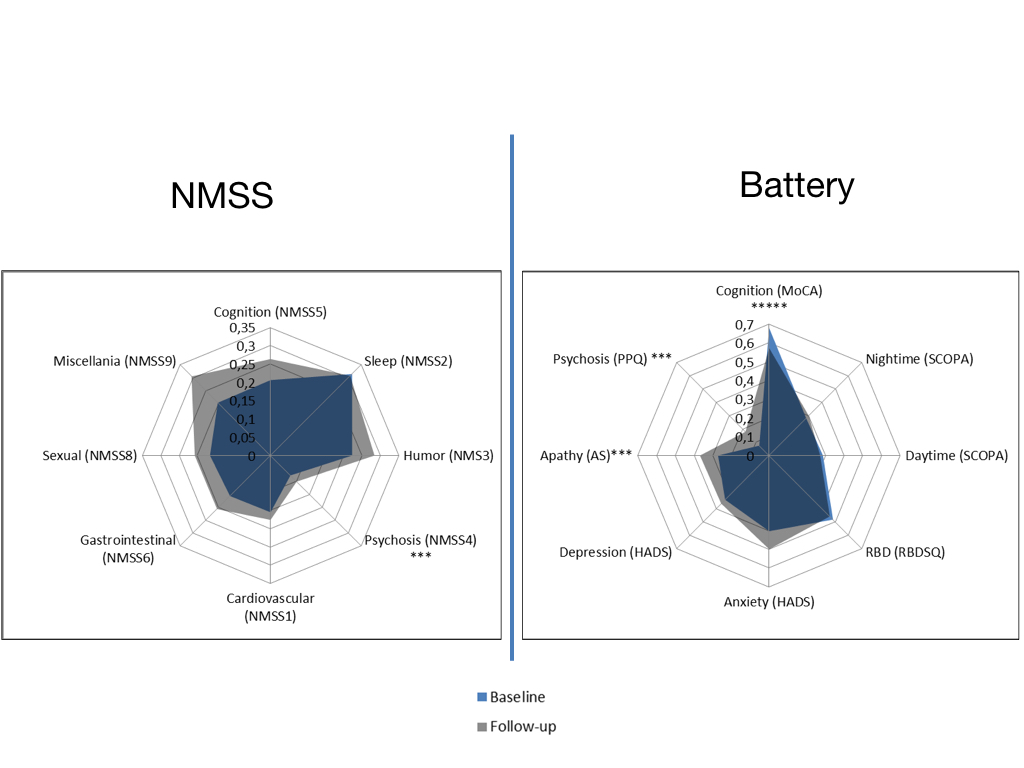Category: Parkinson's Disease: Non-Motor Symptoms
Objective: Assess the progression of motor and non-motor symptoms in Parkinson’s Disease (PD) and predictors of cognitive, motor, activities of daily living (ADL) and Health Related Quality of Life (HRQL) deterioration.
Background: PD is the second most common neurodegenerative disorder and a frequent cause of incapacity and decline of HRQL. There is a need for a better understanding of the factors potentially useful for predicting prognosis, which takes in account the large spectrum of symptoms.
Method: PD patients were assessed at baseline and 4 years later with a protocol including motor function scales (UPDRS III and the Hoehn and Yahr scale) several validate scales for non-motor symptoms (inclunding MoCA) and the Non-Motor Symptom Scale. HRQL was measured with the EuroQol and Incapacity with UPDRS II and Schwab and England scale (S&E).
Linear regression (univariate followed by multivariate) was used with changes in MoCA, HY, EQ-5D and S&E as dependent variables and non-motor symptoms variables as predictors. Two multivariate models were used, with two sets of predictor variables, one including NMSS dimensions and the other using the other several separate non-motor symptom scales. Demographic, disease related data, levodopa equivalente dosis and UPDRS III were used in both models.
Results: Of the initial 134 patients, 72 (54%) were reassessed at follow-up. MoCA (decrease), Apathy Scale and Psychosis (increase) were significantly different at follow-up [Graph 1]. In the multivariate model using the battery of separate scales there was a significant association between S&E and EQ-5D. Using NMSS variables as predictors, we found significant associations between NMSS Perception/Hallucinations and MoCA; NMSS Perception/Hallucinations and EQ-5D; S&E and EQ-5D.
Conclusion: Non-motor symptoms evolve unevenly. Cognitive dysfunction, Psychosis and Apathy worsened significantly. The battery of separate scales had less predictive value than the NMSS. The models used seem to be more useful to predict loss of quality of life (versus the other outcomes). The importance of the previous degree of disability should be highlighted as a to its predictive value. The intensity of hallucinations (NMSS) seems to be an important factor in predicting loss of quality of life and cognitive dysfunction worsening.
To cite this abstract in AMA style:
P. Bugalho, F. Ladeira, R. Barbosa, J. Marto, C. Borbinha, M. Salavisa, M. Saraiva, L. Conceição, M. Fernandes, B. Meira. Progression in Parkinson’s disease: Variation in motor and non-motor symptoms severity and predictors of decline in cognition, motor function, incapacity and Health Related Quality of Life [abstract]. Mov Disord. 2020; 35 (suppl 1). https://www.mdsabstracts.org/abstract/progression-in-parkinsons-disease-variation-in-motor-and-non-motor-symptoms-severity-and-predictors-of-decline-in-cognition-motor-function-incapacity-and-health-related-quality-of-life/. Accessed December 30, 2025.« Back to MDS Virtual Congress 2020
MDS Abstracts - https://www.mdsabstracts.org/abstract/progression-in-parkinsons-disease-variation-in-motor-and-non-motor-symptoms-severity-and-predictors-of-decline-in-cognition-motor-function-incapacity-and-health-related-quality-of-life/

